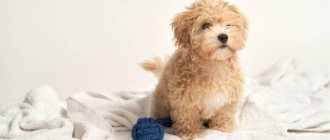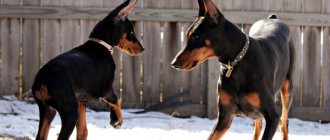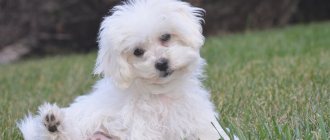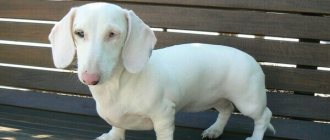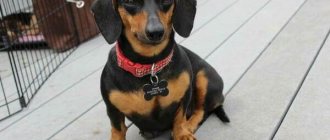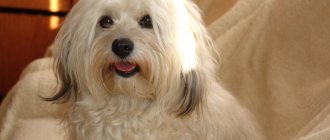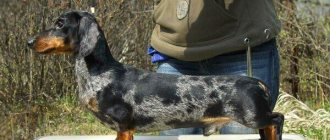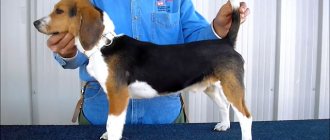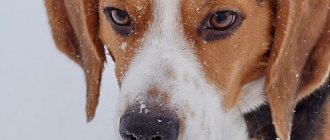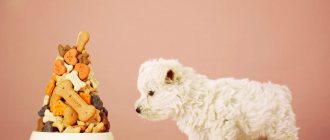Bichon Frizes win the hearts of people with their gentle, lively, inquisitive nature and funny appearance. These playful, expressive cloud-like dogs can become your true friend. What are the features of the breed and what difficulties do Bichon owners face? We will talk about this in our article.
Bichon Frize: description of the breed
Main characteristics
The breed is recognized by all important dog breeding organizations. Breed standard: No. 215 (adopted 05/11/1998):
- Weight - 3-5 kg.
- Height - 20-30 cm.
- The eyes are black, with black edging.
- Nose is black.
- The physique is strong, the paws are short, the constitution is dry, and the bones are solid.
- The forehead is flat, merging into the bridge of the nose. In preparation for exhibitions, Bichons are cut so that they look like a cloud, and their heads look huge and round.
In preparation for exhibitions, Bichons are cut so that they look like a cloud.
- The coat is thick, long, curly, and always white. At an early age there are spots, but as they grow older they disappear.
- Personality: cheerful, sociable, friendly, courageous, courageous, adaptive.
- They are easy and fun to train.
- Active, mobile lifestyle.
Bichons are the progenitors of all types of lapdogs
Breed standard
French dog handlers determined what qualities the Bichon Frize breed should meet, and this happened in 1933. Somewhat later, already in the 70s, lap dogs were approved in the United States and England.
The standard looks like this:
- weight – 3 – 6 kg;
- height at withers – no more than 30 cm;
- color - only white. The length of the coat is 7–10 cm, there are corkscrew curls. This specific structure ensures little hair loss during the molting season;
- life expectancy – a small pet will delight its owner for 12 – 15 years;
- character trait - lapdogs are completely non-aggressive, they are sociable, playful and good-natured. Frisian affection reaches such a degree that animals are ready to follow a person everywhere just so as not to be left alone;
- intellectual qualities were rated above average. It is common for a pet to quickly learn the rules of life in a new habitat. The dogs are highly trainable;
- security qualities are poorly developed;
- The body is rectangular, the cervical region is strong, rounded, flexible, widening towards the shoulders. The withers are inconspicuous;
- The sternum is wide, of sufficient depth, and has a rounded keel. The belly should be tucked up and not drooping, which will interfere with the dog’s movement;
- paws with well-developed muscles, located parallel to each other.
Care
You can easily keep a dog at home if you have enough space and opportunity to run and play. There will be no smell if you frequently bathe your dog and wet clean the house. He communicates affectionately with children and becomes a good friend for any person. He is very trainable, brave, flexible and patient. Quickly adapts to new conditions. By the age of one year, you can learn to perform simple commands. If you try, your pet will be happy to fetch slippers or perform simple tricks.
The Bichon Frize communicates affectionately with children and becomes a good friend for any person.
They live a long time, 15-20 years, are in good health, tolerate heat and cold well. However, if they are bored, they can make noise and go destroy everything around them.
Description of Bichon Frize
The owners of these dogs often say that their pet knows how to smile.
Bathing
- You need to bathe your pet 2 to 4 times a month or more often, for example, in rainy weather. Paws need to be washed after every walk, because the white coat gets dirty quickly if you do not use special clothing.
- Buy shampoo for white dogs. Some people add boric acid to the bathing water to make the coat whiter.
- After water treatments, you need to use a balm, dry the coat with a towel and dry it with a hairdryer.
You need to bathe your Bichon Frize 2 to 4 times a month.
Wool
A haircut must be done at least once every two months to keep the dog looking neat, combing every day, because the hair gets very tangled and tangles form. For combing, pet stores usually purchase a whole arsenal: a slicker brush, round scissors, metal brushes, combs, combs, a trimmer for the area under the tail and an anti-tangle spray.
Attention! When purchasing a dog of this breed, be prepared for the fact that you will have to scratch a lot, often and very carefully.
FCI standard No. 215: breed description
Hygiene
During estrus, special diapers are purchased. In the area under the tail, the hair is trimmed to 3-4 cm. In addition, you should clean the ears weekly with cotton swabs and a solution, and pluck hairs in the ears to avoid the risk of bacterial infections. Don't worry: the plucking procedure is painless for the dog due to the weak sensitivity of the inner surface of the ears. During grooming procedures, carefully inspect your ears for ear mites.
Ear before and after treatment
Important to consider! Dogs of this breed have runny eyes. Therefore, every day be sure to clean the face with warm water, treat it with a special product and be sure to dry it so that bacteria do not multiply. Sometimes stains remain even with proper care and in the absence of health problems. In this case, breeders recommend using professional cosmetics (powder, wipes, lotions) to lighten the coat.
Once a month, trim the nails with nail clippers so that your pet looks neater and walks with the correct gait. Ask the breeder to show you how to do this correctly; later you should not have any problems in this matter.
The Bichon's mouth requires regular inspection.
Inspect your Bichon's mouth regularly. Dental problems can occur, so it is better to prevent them at an early stage. The teeth should not be brown at the base and the gums should not be red or swollen. If you don't see pink gums or white teeth, it's most likely tartar, so it's time to see your veterinarian.
Characteristics of the Bichon Frize breed
Get into the habit of brushing your teeth from childhood. You need to brush your teeth with your finger or a baby brush with toothpaste for dogs, using movements from the root of the tooth. To prevent tartar, give tablets, hygiene sprays and chew toys.
If you got a dog to participate in shows, the care will be different from the standard. Preparing for the exhibition will take a lot of time and work. If you are not a professional dog breeder, it is better to send your dog to a special salon for training.
Preparing for a Bichon show will take a lot of time and work.
A haircut
Options
Popular haircut options:
- Exhibition or decorative. It is suitable for animals that are shown in competitions.
- Regular haircut. It looks great on this breed and makes grooming much easier. The fur is cut as short as possible, but not so that the pet is bald.
- Panda. This hairstyle is not as long as the first one. But she is more magnificent than the second one. In this variation, the head, tail, chest and area behind the legs are left super fluffy.
How to cut your hair correctly
To trim your pet's hair at home, you need to follow a few simple things:
- Using a #30 blade, trim the fur around the pads of the feet.
- Using a #10 blade, trim the fur near the genitals.
- Use the A-type attachment to trim hair from the sides, belly, thighs and legs.
- Use scissors to trim the area around the foot when the foot is naturally resting on the table.
- Use scissors to trim the fur on your pet's paws, front and back.
- Trim the corners of the eyes and above them, as well as the back of the pet's head, using thin scissors.
- Brush your ears and cheeks. Next, trim the hairs there, rounding the ears into the head.
- Comb the hair at the top of your head up and out and cut it into a round dome shape.
How often?
The pet needs to be cut approximately once every 1.5-3 months according to the recommendations.
Nutrition
You can feed him with a special balanced food (100 g per day), natural food and only hypoallergenic meat (rabbit, turkey). Raw meat should be cut into small pieces and scalded with boiling water. Raw food is also recommended for consumption: cereals, vegetables, meat, fish. You need to feed twice a day, chop large pieces. If feeding dry food, it is necessary to ensure constant access to clean drinking water.
You should carefully consider the choice of diet, as improper nutrition can cause allergies. Calcium and other mineral supplements prescribed by your veterinarian should be given with food.
You should be careful when choosing your Bichon's diet.
The main thing: do not let your dog eat from the table.
Attention! Choose natural foods without dyes. Otherwise, tears may flow from the eyes and leave red marks on the face.
Health
This breed has a list of characteristic diseases, the most common of which is allergies. Usually, a predisposition to diseases is inherited and is easily calculated by breeders; further spread of the defect is not allowed. However, carefully study the heredity before purchasing a puppy. Among the most common diseases:
- hemophilia;
- retinal atrophy;
- heart problems;
- allergy;
- dislocations.
In cold or rainy seasons, it is necessary to dress your dog
Let's repeat and supplement our advice.
- Do not let your dog jump from heights or play with large dogs because there is a risk of dislocating his kneecap.
- You should carefully monitor the condition of the ears, teeth and claws.
- To avoid allergic reactions, feed the right food, no chicken or beef.
- In cold or rainy seasons, you need to dress your dog so that he does not freeze. Keep away from cigarette smoke. Some owners purchase a wardrobe that includes boots so that after a walk they do not have to wash their paws several times a day.
- Monitor your weight; sudden changes may indicate illness.
- Check your dog regularly for fleas and ticks and monitor its condition and body temperature. As spring approaches, the threat of catching an ixodid tick on a walk intensifies. Ticks, mosquitoes, midges and fleas carry a large number of diseases, including piroplasmosis, which can make your dog feel unwell. To prevent this from happening, treat your pet for ectoparasites once a month, applying the mixture between the shoulder blades.
Bichon Frize character
If your dog is bitten by a tick, take him to the veterinarian. There it will be removed, processed and tested.
Varieties
Today, several breed subgroups have been identified, which include lapdogs with similar appearance and characteristics. They differ in the place of breeding and growth.
You can get acquainted with the varieties of Bichons in the table below.
Breed diversity
| Breed name | Short description | Peculiarity |
| Havanese (Havanese Bichon) | They have a lush coat, which can be either white or have various shades of brown, spotting is allowed. Representatives of the breed get along well with children and pets. | Highly people-oriented. If a dog is left alone for a long time, it will find entertainment in the form of damaging furniture, carpets, etc. Havanese is considered a rare breed in the Russian Federation |
| Bolognese dogs (Bolognese) | The short fur on the face becomes longer on the rest of the body. The dogs have a square-shaped body, unlike other Bichons. | The dog's complete inability to remain alone for more than a few hours. If the owner of the Bolognese leaves the house for a long time, then the neighbors will have to listen to the dog’s very loud protests expressed by barking or howling. |
| Maltese dogs (Maltese) | Belong to the decorative group. The coat is long and requires careful care from humans. Despite the lack of watchdog qualities, the Maltese will easily bark at a stranger, and may even bite him. | The lack of undercoat makes representatives of the breed desirable pets in the home of people with allergies. It is especially worth noting that Maltese dogs have diseases that are inherited. Just like other Bichons, they cannot stand being alone. |
| Levchens (lion dogs) | They are also lap dogs and have a friendly and affectionate character. Do not show aggression towards other pets | There are no genetic diseases. There is no shedding process as such in dogs. Taking care of the pet’s coat will take up quite a lot of the owner’s time, and periodic visits to the groomer are not a cheap pleasure |
| Coton de Tulear (Madagascar Bichon) | They are similar to Havanese, and breeding work on natives from Madagascar has not been completed to date | Ideal pets for families. The dogs are very attentive, playful, and vigilant. Perfectly adaptable both in an apartment and in a country house. Cotons require intensive socialization and appropriate training to avoid behavior problems. |
| Russian colored lapdogs | For this breed, the standard provides for any colors, with the exception of snow-white. The dog is very intelligent and clearly captures the mood of the owner | Activity and endurance allow the lapdog to take long walks with the owner. Thanks to its good adaptability to transportation, the dog will be able to go with a person on any trip. |
Human Compatibility
The Bichon Frize is less likely to give you allergies than other dogs. With proper maintenance (frequent combing of wool and wet cleaning of the apartment), it is also suitable for allergy sufferers.
He is happy with his owners and guests, is friends with children, and does not get into fights.
The Bichon Frize is less likely to cause you allergies.
Nicknames
When owners choose a name for their pet, they can find inspiration from many sources. Do you have a favorite musician? Literary character? Song? TV show? All this may lead you to a suitable nickname.
For boy
Boys can be named by the following names:
- Becks.
- Charlie.
- Cody.
- Kobe.
- Dustin.
- Jack.
- Lucas.
- Harry.
- Maximus.
- Murphy.
- Oliver.
- Oscar.
- Ross.
- Sammy.
- Toby.
- Teddy.
- Romeo.
- Raphael.
- Bosco.
- Gabriel.
- Andrian.
- Jacques.
- Tory.
For girl
Popular names for girls:
- Angel.
- Annabelle.
- Boni.
- Brandy.
- Buffy.
- Cherry.
- Chloe.
- Coconut.
- Fifi.
- Heidi.
- Jasmine.
- Lady.
- Lucy.
- Star.
- Poppy.
- Rose.
- Roxy.
- Sasha.
- Shelby.
- Zoe.
- Adele.
- Alice.
- Ava.
- Juliet.
- Mia.
- Mila.
Where can I get a purebred puppy?
Buying a Bichon Frize puppy is not that difficult. The cost for each dog is individual. A large number of nurseries and breeders are ready to sell you a dog with all the appropriate seals and documents at a price of 15 to 40 thousand rubles. This price is higher than that of private breeders, from whom you can purchase a purebred Bichon for 7 thousand rubles. Mixed breeds crossed with other small breeds cost about the same, are sold without papers, but can be very cute. This difference in cost is due to a number of advantages of licensed nurseries:
- Animals are guaranteed to be kept in the right conditions, fed as they should be, and are under constant supervision of a full-time veterinarian.
- The breed is designed according to all standards.
- Some kennels provide a number of free accompanying services, such as delivery of the animal, consultations throughout the dog's life, and even some medical care.
Bichon frize puppy
The best nurseries are considered to be “White Star” and “Tsvetnoy Barberry”, Moscow.
What other factors does the cost depend on?
- Age. The most expensive puppies are 3-4 months old. Puppies are not sold before 3 months.
- Origin - titles that the puppy’s parents received at exhibitions and competitions.
- Exterior. The puppy's appearance must meet all breed requirements
- Nursery level. The conditions in which the purebred puppy was born and raised. Plus the geographical location and all the costs of maintenance and feeding.
Breeding
Breeding the breed is quite an expensive process. Females are often unable to give birth to puppies themselves, so they require a caesarean section.
Girls have their first flow at the age of 12 months. Subsequently, this happens every six months. It is recommended to breed a female dog 10-14 days after the start of her heat.
Be sure to introduce the animals before mating, and also get all the necessary vaccinations in advance. If a girl is ready for mating, she will raise her tail high up. The process lasts from 30 minutes to an hour. It is necessary to monitor the couple, as the male can injure the female during mating.
The pregnancy of an individual lasts 55-68 days. The girl's mammary glands swell and her tummy begins to be visible after the first month. You can feel the baby moving at about 2 months. Remember, you should not overfeed your baby girl, as excess weight will adversely affect childbirth. Include foods high in vitamins and calcium in her diet, which will help the healthy development of her offspring.
The following signs will indicate an imminent birth: the mother will begin to refuse to go for walks, will dig her litter, will become restless, and will not eat well. The day before giving birth, discharge will begin in the form of mucus and blood.
Ensure that a veterinarian is present at the birth who can assist in unforeseen situations.
Cubs are born with an interval of 15-40 minutes. A girl gives birth to 4-5 puppies at a time.
What should you pay attention to when choosing a puppy?
The breeder should be extremely interested in you as a new owner, give detailed instructions, ask questions about the conditions and experience of caring for the dog. If the dog breeder answers briefly or finds it difficult to answer some question about maintenance, try not to contact him.
Breeders do not sell puppies under 3 months of age
- Inspect the room in which the dogs live, it should be clean, bright and fresh, the dogs should be active and happy.
- Study the appearance of the bitch and the stud dog. Check the mating certificate, pedigree, veterinary passport, brand.
- If parents have titles, ask for confirmation: awards, certificates and diplomas.
- Then look at the puppy card issued by the Russian Canine Federation. It will give you the opportunity to participate in all RKF exhibitions.
- The last vaccination in the veterinary passport should be no more than a week ago, and the brand must match the brand on the puppy itself.
- Make sure that the breeder has sufficient rights to sell the puppy, and that the acts of sale and acceptance are completed correctly.
- After checking the documents, talk to other pets, observe them, evaluate their behavior: they should not be lethargic, fearful, hyperactive, too loud or aggressive.
The Bichon Frize will make a great friend and companion.
- Be sure to ask the breeder questions about the dog’s character, hereditary diseases, features and exterior flaws.
- If you want to participate in shows or breed Bichons, but do not have enough experience, do not hesitate to invite an independent expert who will determine compliance with the breed standard to avoid deception.
- The breeder must give you the most detailed recommendations on feeding, care, transportation (certificate F1), and preparation for exhibitions.
Example of F1 form certificate
Origin story
Bichons should not jump from high obstacles as there is a risk of injury.
The historical homeland of the Bichon Frize is considered to be Tenerife, one of the Canary Islands belonging to Spain: the first written records of Barbichons, small dogs with white curly hair, living here date back to the 13th century. Barbichons came to mainland Europe thanks to navigation. Despite their miniature size, the dogs coped well with rodents and reliably protected ship holds from rats, without taking up much space in the rooms below deck.
In the 15th century, having arrived at the court of the French king as a cute souvenir, the animals became extremely popular among the nobility. But these dogs became a real fashion trend during the reign of Henry III (1575 – 1589). The ruler never, even at the most important meetings, parted with his favorite Barbichons. Representatives of the aristocracy, imitating the ruler and demonstrating loyal feelings, considered it their duty to acquire such a living accessory: the snow-white fluffy fur coat of the dogs harmonized so well with the exquisite lace of rich outfits. At the same time, the original name of the breed was shortened to “Bichon”, and the word “Frise” (curly, curled) indicated the peculiarities of the texture of the dog’s coat.
The triumphant march of Bichons across Europe as pets of the privileged nobility continued until the 17th century. The emerging wave of bourgeois revolutions, changing the social meaning of the nobility, also influenced the noble status of animals. We forgot about charming decorative dogs for a while. Only after the 1st World War did individuals begin to gain popularity again. The International Canine Federation officially registered the breed in 1933, and a year later its standard was formulated.
Puppy care
At an early age, you can feed dry, natural or mixed food. Very young puppies should be given heated crushed foods: milk porridge, vegetable puree. Dogs up to one and a half years old are fed frequently - six times a day, but by nine months they have already switched completely to an adult diet. After six months, the puppy begins to grow rapidly and quickly becomes an adult dog.
Attention! There is a list of prohibited foods that should not be given to a dog under any circumstances.
Champion of Kazakhstan
Forbidden:
- Fatty, salty, spicy, sweet (no chocolate!).
- Semolina and pearl barley, legumes.
- Pasta, white bread.
- Sausage.
- Bones (fish and chicken, which can damage a dog’s esophagus).
Video - Caring for a Bichon Frize
Interesting Facts
- Dogs have inspired some famous artists, such as the Spanish artist and engraver Francisco Goya. He immortalized the animal in several paintings. The most famous were: Maria Teresa de Bourbon and Vallabriga (1783), the White Princess (1785).
- This miniature dog is ranked 46 out of 193 places on the American Kennel Club's popularity rankings.
- The view is supported by celebrities such as Ashley Tisdale, Martha Stewart, Christina Aguilera, Jessica Simpson and others.
- One of the most famous Bichon Frize is a dog named Ozzie. He became a social media sensation. This talented pet can perform a whole range of tricks, including skateboarding and helping with laundry. His owner, Kaylee Langdon, created a Facebook page for Ozzy. She wanted to show people what her talented dog could do. The favorite is now so popular that he has over 4,000 followers on his Facebook page.
- Bichon Frizes were popular as entertainers in the 19th century. They often performed in circuses and with street performers such as organ grinders.
- Despite stereotypes, not all breeds love water. This includes the Bichon Frize. The dog begins to get nervous if they approach a body of water with him.
- The Bichon Frize Club of America was founded in 1964 in San Diego.
- Oddly enough, the standards of the species were influenced by the popular children's book by the Belgian author Goerge, “The Adventures of Tintin.” The main character of the book is a small white fox terrier named Milu. Although this pet was a different breed, it made small, white fluffy sands popular. This led to the adoption of an official standard for the Bichon Frize.
- The first Bichon Frize arrived in Australia in 1976. This seems surprising since many families emigrated to the continent and took their pets with them.
- The oldest pet was from North America. He lived for about 19 years.
- The Bichon Blitz is a well-known phenomenon where your dog will suddenly fly around the house for a minute or two and then calm down.
What else should you buy to keep a Bichon?
- Bowls. Two separate bowls or a 1 liter automatic feeder.
- A basket or other place where the dog can sleep comfortably.
- A collar, a two-meter leash and an address tag with the dog's name, address and phone number of the owner.
- Tray.
- The aviary will help accustom the puppy to the tray.
- A carrier for trips to the veterinarian, on a visit or to exhibitions.
- Products and care items in large quantities.
- Rubber toys for the prevention of tartar.
- Veterinary first aid kit.
- Feed and supplements.
How to raise and train a Bichon?
Some owners complain that it is difficult to train them to use the toilet and cleanliness. Having a wayward and courageous character, Bichons can take some liberties such as loud barking and unceremoniously jumping on the bed. In fact, like all dogs, Bichons are highly trainable.
Bichon Frize Personality Traits
If you work with your dog from an early age, he will obediently follow commands. When raising, adhere to the following rules:
- your pet senses your mood, and if you are interested, he will also certainly be carried away by the process;
- Yelling and swearing will not do any good: the key to success in training a Bichon Frize is rewarding with treats and praise;
- all training should be based on three main commands: “You can’t!”, “Come to me!”, “Place!”;
- It is important to proceed carefully and consistently. Don’t dump everything on your dog at once, it’s better to do it regularly;
- From childhood, teach him to use the toilet and grooming procedures, as well as where he should not run or jump.
So, to summarize, we can determine what are the pros and cons of Bichon Frize dogs.
If you train your dog from an early age, he will obediently follow commands
Pros:
- Wonderful character: brave, cheerful, good-natured.
- Suitable for home use.
- Hypoallergenic.
- Small and light.
Minuses:
- Diet restrictions.
- Requires careful care.
- The dogs themselves, hairdresser services and grooming products are expensive.
- Doesn't like to be left alone, and may start acting out or making noise out of boredom.
Video - Bichon Frize: everything about the dog breed
Girl
The differences between a girl and a boy can be determined solely by gender, since the height and weight of both sexes are almost the same.
General characteristics of girls' temperament.
- Independence. Bitches tend to want to be in control of the entire situation. They may come to their owner when they are looking for affection, but often leave when they are tired of it.
- Stubbornness. In many packs, the girl is the alpha dog.
- Territoriality. Bitches mark their territory just like males. They can continue to do this throughout their lives, regardless of sterilization. Most boys stop marking their territory after they are castrated.
- Alienation. Females tend to be less affectionate and friendly than males. This characteristic is noticeable in puppies and becomes more pronounced with age.
- Changes in mood or behavior. It is also important to note that a female dog begins to go into heat at the age of one year. Further, it will occur approximately every six months. During this time, there will be some slight bleeding and odor, as well as changes in the girl's mood or behavior.

